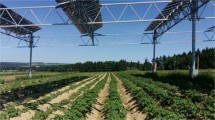Abstract
During the evolution of the human, agriculture and land utilization was inevitably connected with survival in nature. Human activity was not only restricted to the production of agricultural products but also extended into many other sectors, such as the production of several industrial-made products, mining, and usage of fossil fuels as a standard method of generating electricity. However, the intense urbanization phenomenon ultimately caused, during the last few decades, the degradation of our natural environment. As a result, the quality (and quantity) of produced food we consume has significantly decreased. The need for the evolution of alternative methods of cultivation is constant and always a hot topic, especially in order to confront the multiple problems that conventional agriculture has. Hydroponics, an innovative cultivation method, comes to solve many of these problems.



Similar content being viewed by others
References
Barbosa GL, Almeida Gadelha FD, Kublik N, Proctor A, Reichelm L, Weissinger E, Wohlleb GM, Halden RU (2015) Comparison of land, water, and energy requirements of lettuce grown using hydroponic vs. Conventional agricultural methods. Int J Environ Res Public Health 12(6):6879–6891
Bavec M, Robačer M, Stajnko D, Vukmanić T, Bavec F (2014) Sustainability of vegetable production systems evaluated by ecological footprint, 4th ISOFAR Scientific Conference. ‘Building Organic Bridges’, at the Organic World Congress 2014, 13–15 Oct., Istanbul, Turkey
Bundschuh J, Tomaszewska B, Ghaffour N, Reardon-Smith K, Chen G, Mushtaq S, Hamawand I, Maraseni T, Banhazi T, Mahmoudi H, Goosen M, Diogenes L A (2017) Solar, wind and geothermal energy applications in agriculture: back to the future? Research Gate.com, chapter. 1, pg. 1–3, 5–10
Danish Agriculture & Food Council (2018) Available from: https://agricultureandfood.dk, (Access: 9 August, 2018)
Estrada A (2017) Utilization of natural light in indoor applications: simulation and implementation, Texas State University, chapter. 1, 2, pg. 2–3, 15–18
European Commission (2015) Sustainable agriculture, forestry and fisheries in the bioeconomy—a challenge for Europe, 4th SCAR Foresight Exercise, Research and Innovation, Brussels, ch. 2, pp. 23–24, 53, 57, 65, 85, Available at: https://ec.europa.eu/research/scar/pdf/ki-01-15-295-enn.pdf (Access: 16 February, 2018)
Gent MPN (2014) Effect of daily light integral on composition of hydroponic lettuce. Hortic Sci 49(2):173–179
Ghanbarian B, Hunt AG (2017) Fractals: Concepts and applications in geosciences. CRC Press, pp. 1–351
Gray D, Laing R, Docherty I (2017) Delivering lower carbon urban transport choices: European ambition meets the reality of institutional (mis)alignment. Environ Plan A 49(1):226–242
Hansen J, Ruedy R, Sato M, Lo K (2010) Global surface temperature change. Rev Geophys 48:RG4004. https://doi.org/10.1029/2010RG000345
Hoekstra YA, Wiedmann OT (2014) Humanity’s unsustainable environmental footprint. Science 344(6188):1114–1115
International Energy Agency (2012) Energy technology perspectives 2012—pathways to a clean energy system Available at: http://www.iea.org/Textbase/npsum/ETP2012SUM.pdf (Access: 12 February, 2018)
Kozai T (2013) Resource use efficiency of closed plant production system with artificial light: concept, estimation and application to plant factory. Japan Academy 89:448–449
Liaros S, Botsis K, Xydis G (2016) Technoeconomic evaluation of urban plant factories: the case of basil (Ocimum basilicum). Sci Total Environ 554-555:218–227
Maboko MM (2014) Hydroponic vegetable production—about hydroponic vegetable production. Agric Res Council Available at: http://www.arc.agric.za/arc-vopi/Pages/CropScience/Hydroponic-Vegetable-Production.aspx (Access: 07 November, 2017)
Maximum Yield (2017) Daily light integral (DLI)—definition. Available at: https://www.maximumyield.com/definition/3045/daily-light-integral-dli (Access: 11 February, 2018)
Miličić V, Thorarinsdottir R, Dos Santos M, Hančič Turnšek M (2016) Commercial aquaponics approaching the European market: to consumers’ perceptions of aquaponics products in Europe. Water 9(2):80. https://doi.org/10.3390/w9020080
NASA GISS GISTEMP (2018) Land–ocean temperature index (LOTI). Available from: https://data.giss.nasa.gov (Access: 2 September, 2018)
Ouzounis T, Rosenqvist E, Ottosen CO (2015) Spectral effects of artificial light on plant physiology and secondary metabolism: a review. Hortic Sci 50(8):1128–1135
Pandey D, Agrawal M, Pandey SJ (2010) Carbon footprint: current methods of estimation. Laboratory of Air Pollution and Global Climate Change, Ecology Research Circle, Department of Botany, Banaras Hindu University, India Available at: https://www.researchgate.net/publication/46289480_Carbon_Footprint_Current_Methods_of_Estimation (Access: 10 February, 2018)
Perez C (2009) Technological revolutions and techno-economic paradigms, Working Papers in Technology governance and Economic Dynamics no. 20, The Other Canon Foundation, Norway, pp. 3–6, 8–11, 13–15, 18
Resh HM (2013) Hydroponic food production: a definite guidebook for the advanced home gardener and the commercial hydroponic grower, 7th edn. Taylor & Francis Group: CRC Press
Santos JD, Lopes da Silva AL, da Luz Costa J, Scheidt GN, Novak AC, Sydney EB, Soccol CR (2013) Development of a vinasse nutritive solution for hydroponics. J Environ Manag 114:8–12
Sindelar M (2015) Soils support agriculture. J Soil Sci Soc Am Available at: https://www.soils.org/files/sssa/iys/march-soils-overview.pdf (Access: 29 October, 2017)
Srinivas H (2003) What is energy footprint? Available at: https://www.gdrc.org/uem/footprints/energy-footprint.html (Access: 8 February, 2018)
Vox G, Teitel M, Pardossi A, Minuto A, Tinivella F, Schettini E (2010) Chapter 1: sustainable greenhouse systems. In: Salazar A, Rios I (eds) Sustainable agriculture: technology, planning and management. Nova Science Publishers, Inc., NY ISBN: 978-1-60876-269-9: 1-79
Wiedmann T, Minx J (2008) chapter 1: A definition of ‘carbon footprint’, Pertsova CC, Ecological economics research trends, Nova Science Publishers, Hauppauge, pg. 1–11 Available at: https://www.novapublishers.com/catalog/product_info.php?products_id=5999 (Access: 10 February, 2018)
World Bank (2018a) Agricultural land (% of land area) 1961–2015, Available from: https://data.worldbank.org/indicator/AG.LND.AGRI.ZS?end=2015&start=1961&view=chart&year_high_desc=false
World Bank (2018b) World development indicators, Available from: https://datacatalog.worldbank.org/dataset/world-development-indicators
Xydis G (2015) A wind energy integration analysis using wind resource assessment as a decision tool for promoting sustainable energy utilization in agriculture. J Clean Prod 96:476–485
Xydis G, Liaros S, Botsis K (2017) Energy demand analysis via small scale hydroponic systems in suburban areas—an integrated energy-food nexus solution. Sci Total Environ 593–594:610–617. https://doi.org/10.1016/j.scitotenv.2017.03.170
Author information
Authors and Affiliations
Corresponding author
Additional information
Responsible editor: Philippe Garrigues
Publisher’s note
Springer Nature remains neutral with regard to jurisdictional claims in published maps and institutional affiliations.
Rights and permissions
About this article
Cite this article
Manos, DP., Xydis, G. Hydroponics: are we moving towards that direction only because of the environment? A discussion on forecasting and a systems review. Environ Sci Pollut Res 26, 12662–12672 (2019). https://doi.org/10.1007/s11356-019-04933-5
Received:
Accepted:
Published:
Issue Date:
DOI: https://doi.org/10.1007/s11356-019-04933-5




